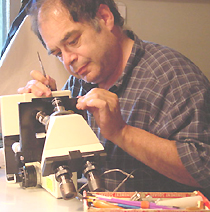
| T H E N I H C A T A L Y S T | S E P T E M B E R – O C T O B E R 2002 |
| |
|
|
|
BRODY'S SITE:
NO FLY-BY-NIGHT
 |
What began as the curiosity-driven project of a research scientist moving from one field to another has grown into one of the most functional and acclaimed websites in cyberspace today. "The Interactive Fly," Thomas Brody’s invention to comprehend Drosophila biology, has been honored with a 2002 Sci/Tech Web Award from ScientificAmerican.com, which hails the site as a "monumental magnum opus that has become a standard in the field of developmental biology."
The Interactive Fly website features information on tissue and organ development, gene hierarchies and their functions, biochemical and developmental pathways, images—and more.
 |
| Thomas
Brody |
Brody, a senior NINDS fellow and member of the Neurogenetics Unit, in Ward Odenwald’s laboratory, actually created this website as a means of facilitating his career transition from immunology and genetics to developmental biology, using Drosophila as a model organism. "I found it difficult to assimilate all the fragmentary information in the literature and realized that if I wanted to display the hierarchy of gene activation, repression, interactions, and protein interactions—to move up and down the developmental hierarchy—the only way to do this would be in cyberspace." Brody persevered more than two years–cataloging, indexing, cross-linking—and the Interactive Fly was born in the summer of 1996.
Six years later, the site now contains information that would fill more than 10 volumes of the Encyclopaedia Britannica, receives more than 3 million hits a year, and is used by everyone from high school students to senior researchers and grant reviewers. It’s now hosted by The Society for Developmental Biology and FlyBase, the database of the Drosophila genome.
FlyBase itself, a consortium of groups in the United Kingdom, Harvard University (in Cambridge, Mass.) and the University of Indiana at Bloomington, is "perfectly adequate," Brody says, but does not so easily allow users "to move from gene to gene seamlessly and understand interactions and hierarchies." With the Interactive Fly website, on the other hand, novice or expert can maneuver through and grasp the Drosophila genome with just a few clicks.
Another way the Interactive Fly is "different from anything else on the web," Brody says, is that it is "text-based" not "database-based"—all the information on the site has been published elsewhere, is cross-linked accordingly, and is presented in context. Given that more and more Drosophila genes are being discovered, along with their vertebrate homologs, the format is especially useful for all biologists.
For each gene, the site provides information on vertebrate evolutionary homologs, gene regulation and targets of activity, protein expression and effects of mutation, and—most important, says Brody—a biological overview that explains in understandable fashion aspects of a gene’s discovery and biological function. The user-friendly text is largely the work of Judy Brody, the site’s meticulous editor and Thomas Brody’s wife.
Asked about similar websites for other models, Brody says "we are continually talking about how to parse the information of the Interactive Fly into a database format highlighting information on other organisms—but we have not made any commitments yet."